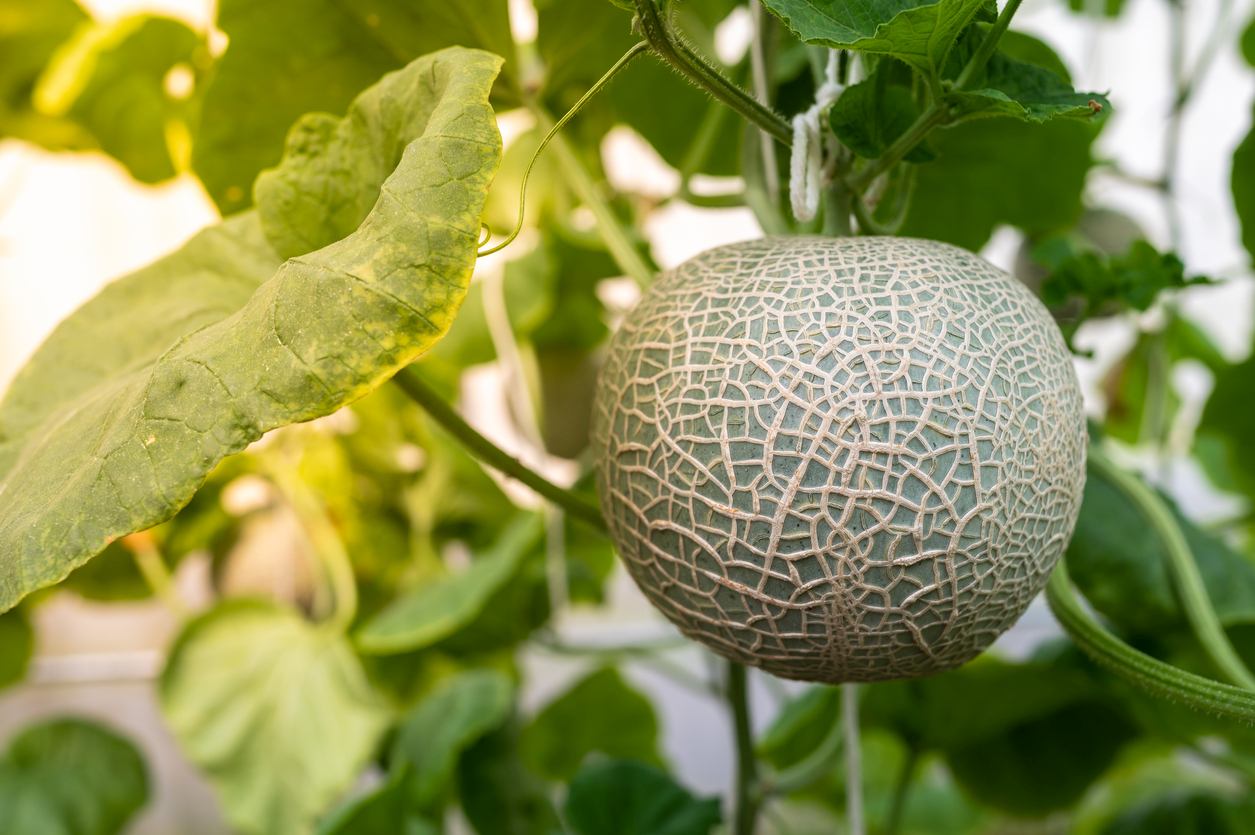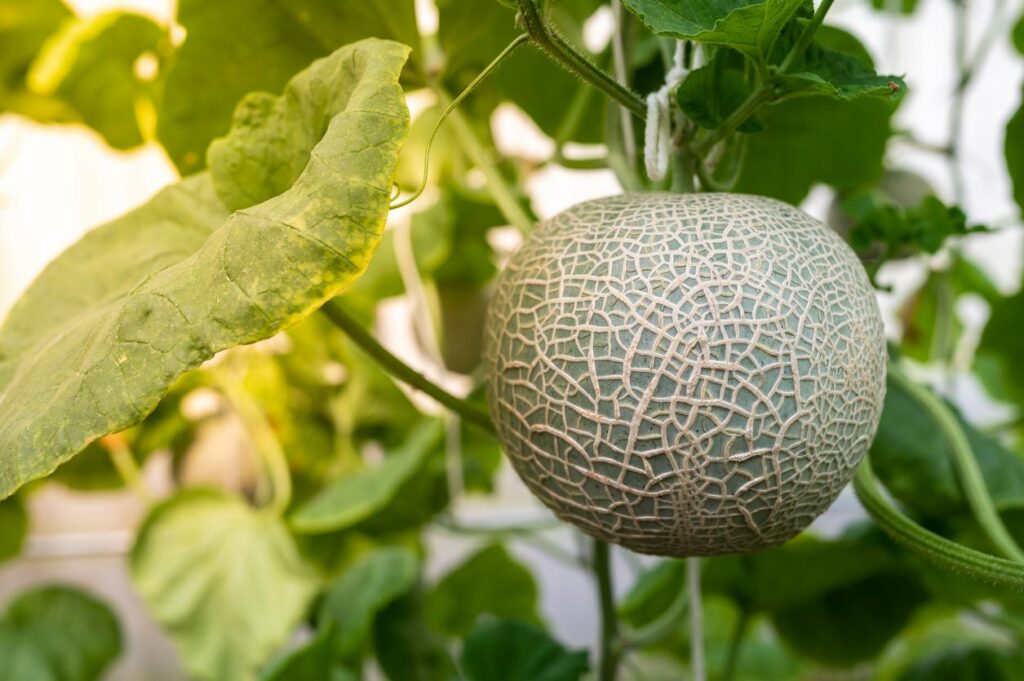Growing Cantaloupe – How To Care For And Harvest Cantaloupes
Juicy, lavish, and sweet, the cantaloupe is a refreshing and nourishing summer delicacy. Some people prefer the crunchy watermelon, but the cantaloupe always wins with its smoother flesh and delicate flavors. In a smoothie, fruit salad, or as juice, you can never go wrong with this summer fruit. But did you know that the tastiest cantaloupe is the one you grow right out of your garden? At least that’s what most gardeners claim and they’re rarely wrong.
But which cantaloupe variety to grow? And why not try muskmelon? So many questions to ask yourself before you have even broken the topsoil. Let’s delve into the wonderful and flavorful world of cantaloupes and while we’re there, answer these questions.
Cantaloupe at a Glance
While the name of the cantaloupe (Cucumis melo var. cantalupensis) can be traced back to a small town in Italy called Cantalupo, that’s not the original place of this fruit. It is believed that cantaloupes were first grown in Africa or South Asia before they found their way on merchant ships to Italy. From there, the juicy fruit became a sensation all over Europe before it arrived in the New World in the late 19th century.
The vine of the cantaloupe is distinguished with large dark green leaves and hairy stems. You really need to be careful when handling the mature plant because of all of those tiny spikes. The flowers of the cantaloupe are classified as male and female. Each plant grows both types and they have to be pollinated for the vine to produce fruits. The female flower is often larger with a round swelling at the base where the cantaloupe fruit will develop after pollination.
The fruit itself comes in various shapes and textures. It can be perfectly round or oval. The skin is often patterned and a little rough. It gets rougher as the fruit becomes ripe. You should always let the cantaloupe ripen on the vine before you cut it.
Cantaloupe Varieties
As you might expect, agriculturalists were not happy with the cantaloupe that grew in Italy, and soon many cultivars spread out. But we can trace all these cultivars to 6 cantaloupe types.
- Charentais Cantaloupe: One of the best varieties out there with superior texture, flavors, and taste. It comes from Western France and has a small fruit that weighs no more than 2 pounds each. The outer skin is unusually smooth and is gray-green when fully ripe. Inside, the smooth flesh is compact with the color of salmon-orange. It is both very sweet and aromatic.
- North American Cantaloupe: Although it’s called cantaloupe, many argue that this variety is just muskmelon. The rough skin is heavily patterned and is yellow in color. The rind is usually thinner than you’d expect from a cantaloupe but the flesh inside is just as sweet and flavorful. The ripe fruit is usually tan but the flesh is the usual orange and pulpy.
- European Cantaloupe: The rind here is tough and is usually yellow with green outlines. You won’t see any heavy cobweb patterns on the outer skin while the flesh inside is sweet and musky. This is believed to be the original cantaloupe species that came to Europe from Africa or South Asia. It is still the dominating cantaloupe species all over the world.
- Asian Cantaloupe: Originally from Iran, this cantaloupe has a thin outer skin, yellow in color, and covered with a pronounced mesh. The flesh of this type is a little paler than other varieties and has a crisp texture.
- Galia Cantaloupe: A very distinct type with a smooth but netted outer rind and pale green flesh. It is rich in flavors and sweetness and is quite popular all over Asia. The ripe fruit is smaller in size than the European and North American cantaloupes but is a lot sweeter when served chilled. It has many vitamins and minerals and has low calories.
- Japanese Cantaloupe: Also known as the crown melon, it’s one of the largest cantaloupes out there. Originally grown in Japan, it’s one of the most expensive fruits you can come across. Its beauty is only matched by its sweet taste. The ripe fruit is perfectly round and has a smooth rind. The flesh is pale orange.
How to Grow Cantaloupe
Say what you like about cantaloupes and their origins, there’s no doubt that every gardener is tempted to grow them. It’s not just the delicious fruits, cantaloupes are usually easy to grow. If this is your first ever fruit patch, you’re in luck. Here’s how to grow cantaloupes in easy steps.
- Start cantaloupe seeds indoors about 8 weeks before the last frost.
- Choose the right variety seed from a reliable source and make sure the seeds are good.
- Select a small-size pot or container that’s at least 4 inches in diameter. You should have a pot for each seed.
- Fill the container with peat or other organic material.
- Water the mixture enough to get it moist without overwatering it.
- Plant the seed about an inch deep into the soil and cover it with the mixture. Do the same for the rest of the seeds.
- Keep the container in a dry and dim-lit room with a temperature averaging 65 degrees Fahrenheit.
- The seeds will germinate after about 10 days from the day you plant them.
- Increase the temperature in the room to 70 degrees and keep the soil moist.
- About 4 weeks from the last frost you can transplant the cantaloupes to the garden.
- Prepare raised mounds or hills about 24 inches high for the cantaloupes.
- Dig a hole for each seedling as deep as the height of the container you started it in.
- Remove the whole seedling with all the mixture in the container intact. Make sure not to disturb the sensitive roots.
- Place the seedling in the hole and fill it with soil.
- Space the cantaloupe plants about 18 inches apart to give them space to grow and crawl.
Cantaloupe Care
Did we say that planting cantaloupes was easy? Well, in a way it’s straightforward if a little protracted. But when the little vines are crawling all over the mounds looking healthy and green, it’s time to turn to the second part of the process. Here you’ll need to focus not just on water and fertilizing, but also training the vines and pollination.
Soil
While cantaloupes prefer loamy or sandy soil, you also need to plant them in raised mounds or hills to improve drainage. The soil should be neutral. Neither acidic nor alkaline soil will do with this vine. So test your soil before planting and make sure the pH levels are between 6 and 6.5. Too much iron makes the soil alkaline which in turn impacts the growth of the vines. Acidic soil gives you less produce than average.
Water
Undoubtedly, watering is often one of the trickiest parts of growing plants in your garden. As with many juicy fruits and veggies, cantaloupes need lots of water. You should always water the base of the plant to reach the roots faster. Avoid sprinkling water over the leaves or vines since that causes fungal infestations. On average you should give your vines about 2 inches of water a week. If the weather is hot, you might need to increase your watering. Always irrigate the vines in the early morning to give the soil time to absorb the moisture and pass it to the roots. Keep the soil moist but not soaked.
Fertilizer
When it comes to veggies and fruits, you always have a choice between organic materials and chemical fertilizers. Experts recommend that you use as much organic compost and manure as you can to avoid the need for chemical fertilizers. Cantaloupes prefer steer and horse composted manure. They have the right amount of the nutritions the vines need and the slow-release process keeps the plants feeding for weeks at a time without the risk of burning the roots. Chemical fertilizers tend to produce less sweet fruits and the flavors are usually under dispute.
Temperature and Light
Cantaloupes love the full sun. Avoid partial shade and dappled light since the vines need all the warmth they can get. On average they thrive in temperatures between 70 and 90 degrees Fahrenheit. If it drops below 50 degrees F, the vines become shriveled and stop flowering. Any temperature above 90 degrees F puts stress on the vines. The flowers start to droop and the stems become wilted. In that case, a little shade might come in handy and help the plants survive the heat.
Pollinating
Each cantaloupe vine carries both male and female flowers. The female flowers usually have a bulge near the base while the male flowers are thinner and smaller. The female flower has to be pollinated for the unfertilized fruit at its base to develop. You won’t have to do that yourself since bees take that task with enthusiasm. Make sure to grow other flowering plants to draw bees to your garden to pollinate your cantaloupe flowers.
Pests and Diseases
The two most bothersome pests that will keep you vigilant around your cantaloupes are aphids and striped cucumber beetles. Aphids are not strangers to any garden no matter what you grow in it. But it’s the striped cucumber beetles that inflict the heaviest damage on the fruits. While you can hose away aphids, you have to manually pick the beetles and destroy them without delay before they infect the vines with the bacteria they carry.
Many diseases afflict the vines including Alternaria leaf spot, powdery and downy mildew, and stem blight. You should also be wary of root rot which results from overwatering the soil. You should remove the infected vines and destroy them safely before they spread the disease to other plants. Keep your garden and mounds debris-free and remove weeds regularly to discourage insects and pests.
Harvesting
You’ll know that your cantaloupe is ripe when the color of the rind turns from dark green to yellow or tan depending on the variety you grow. Another good sign that the fruit is ready to harvest is when it has reached its full size and it comes off when you move it. Don’t try to yank the fruit from the vine. That means it’s still not ripe. Cantaloupes always ripen on the vine so if you harvest a green fruit you won’t be able to eat it. Overripe cantaloupes become yellow and lose much of the sweetness and flavors.

